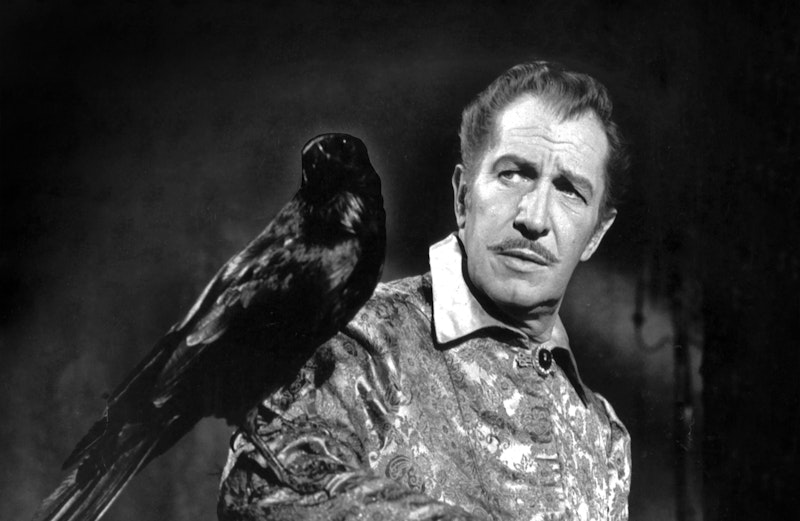When Roger Corman came to make his fifth film based on a story by Edgar Allan Poe in four years, he had a specific angle to explore. A segment in his last movie, Tales of Terror, had matched Peter Lorre with Vincent Price in a humorous story and worked. Corman therefore leaned into comedy with 1963’s The Raven, and made a film that works even better.
Shot in 15 days, the film’s more light-hearted than any of the other Poe movies. It’s also got less to do with Poe. It’s a fantasy story, and one of the best comic fantasies ever shot—because it works both as comedy and as fantasy.
Price is Erasmus Craven, a wizard in the early-15th century mourning his two-years-dead wife Lenore (Hazel Court) when one night his weak and weary pondering is interrupted by a talking raven. Surprisingly voluble, this raven turns out to be another wizard under a curse. Craven returns him to human form, after a couple of tries, and he turns out to be Doctor Bedlo (Lorre), who’d fallen afoul of a third wizard, the powerful and sinister Doctor Scarabus (Boris Karloff).
After Bedlo claims he saw the ghost of Lenore at Scarabus’ castle, Craven and Bedlo decide to visit Scarabus, accompanied by Craven’s daughter Estelle (Olive Sturgess) and Bedlo’s son Rexford (the seventh screen credit of the 25-year-old Jack Nicholson). A series of confrontations and betrayals follows, with clever plot twists, effective suspense, and a thrilling final duel between Craven and Scarabus.
It’s a very funny film, and screenwriter Richard Matheson uses the humor effectively. But he and Corman also develop a consistent world, with a complex backstory that sets up the rapid-fire double-crosses and surprise revelations in Scarabus’ castle. Magic is sometimes played for laughs, as when Price and Bedlo fumble ingredients together to make a potion to return Bedlo to human form, but sometimes evokes wonder and fear.
Character’s also consistent. Craven’s grief for his wife’s death is an effective melancholic note that colors the early part of the film. Bedlo’s cowardice is funny and also key to the plot. Rexford is a brave romantic hero, and also (thanks in large part to Nicholson’s acting choices) a wry cynic. It comes together to build a story with its own internal logic and tone.
There are horror elements in the film: Karloff sells Scarabus as threatening, and Corman’s fascination with rats and creepy-crawly bugs comes out a couple of times. But the movie’s too light-hearted to sustain a horrific tone. Horror stories tend to isolate their protagonist; Craven always has some mix of Estelle and Rexford and Bedlo close by. Nor does he ever appear terrified or despairing. He’s aware of the power Scarabus possesses, but also has real power of his own.
One of the great virtues for Price in these films is that he always knows exactly what kind of story he’s in. He’s able to modulate his approach to create the right character, played at the right pitch—broad when he needs to be broad, subtle when it’s appropriate. He knows how to be just a little bit more subtle than the material really needs, and so it is here. Craven’s a droll and often-befuddled old man, but also in Price’s playing he’s sad and humble and has inside him the heart of a hero.
The movie’s ultimately a hero-tale, with a sympathetic mystic champion who can cast bolts of light from his hands. You can see the seeds here of Marvel Comics’ Doctor Strange, who debuted later in 1963 and was supposedly based on the appearance of Vincent Price. (There’s also a scene where the wizards dress to go out, and we catch a glimpse of an oddly familiar gold-bordered red cloak.) Price isn’t the first figure you’d think of as an action hero, but it’s successful, not least because he’s up against one of the great screen heavies.
Price is surrounded here by perhaps the best supporting cast of any of the Corman Poe films. Peter Lorre plays a thoroughly Lorre character, untrustworthy, unhappy and sardonic. His straight-faced gloom laced with exasperation is an excellent foil for Price’s cerebral Craven. Similarly, Karloff’s Scarabus is tailor-made for Karloff to play, urbane but always threatening. You have the sense of a man with a constant potential for violence, which sometimes erupts in the form of magic that warps the universe itself.
Hazel Court and Olive Sturgess are a bit overshadowed by the veteran stars around them, but Court does handle a surprisingly complex character well. And then there’s young Nicholson, so out-of-place here to modern eyes in a light-hearted fantasy. But this is reading history backwards, and he gives an air of menace to a straightforward young hero.
It’s Important to mention the special effects, perhaps more crucial to this film than any of Corman’s other Poe movies. They’re clearly done on a budget, but effective. The concluding battle in particular has to be one of the best wizards’ duels ever put to film. It all feels like a classic Ray Harryhausen picture—there’s a more ironic surface, and more deliberate gags, but at heart it’s a rousing wonder-story.
The Corman Poe films have a tone a little like a haunted house attraction at an amusement park, or ghost stories told round a campfire. This one dials down the scares and grossness more than most, but is no worse for that. It’s more kid-friendly than most of the Poe films, but the best kids’ stories have always appealed to adults as well.

